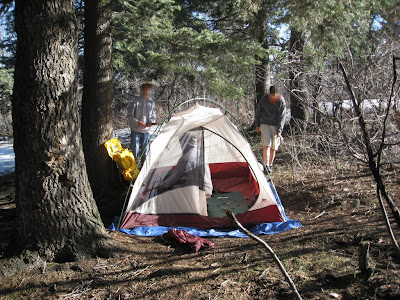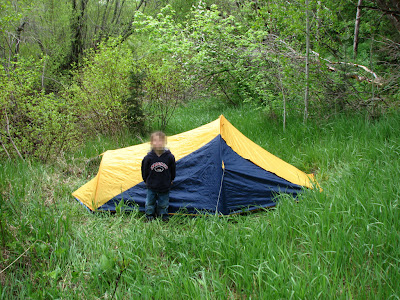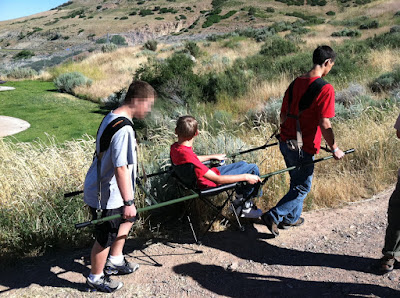Between me and the troop, we've been through a few backpacking tents. You know they have to be pretty durable to stand up to the abuse they get from scouts, but they also need to be lightweight. Then there's the size. What size is best? How big is too big? Will it really fit the # of people that it says it will? Well, I've got a few ideas about backpacking tents that I'll share, but first, let's look at a few tents:
 |
| Our Scouts Backpacking tent. 3-4 Man, and just over 8 pounds |
 |
| A small, 2-man tent made by Eureka, the Zeus 2 |
 |
| Small Tent I got from Smiths Marketplace for around $20 |
 |
The one in the front is an Ozark Trail tent from Walmart ($30). It sets up quick, and has been good for what I've needed it for, but it has some clear panels on the rainfly so you can see the stars that gets brittle and cracks when it's used in freezing temperatures.
The one in the back is a Coleman 8-man tent. Way too big for backpacking of course, but a great car camping tent. I love the "D" door with it's pole in the door that makes it act like a hinge. That way you can go in and out of the tent without wearing out the zipper. |
SIZE
For scouts I like to get 3-4 man tents for backpacking. Typically you can fit one less person comfortably than what it says you can fit. So, our scout backpacking tents that are sized for 4 people, actually fit 3 people pretty well. We have stuffed 4 scouts in there at times, but they weren't too excited about it.
Interestingly enough, a 4 man tent for the scouts, fits 2 adult leaders pretty good. It's kind of weird, but adults don't like to be squished in together in tents. They like a little more room. So, the Ozark Trails tent that is pictured above is pretty good size for 2 adults.
WEIGHT
The lightest backpacking tent I have is the Eureka 2-man tent in the photo above. It doesn't have a rain fly - the walls/roof of the tent act as the rain fly. Since it doesn't have a rain fly, it weighs in just under 4 pounds. It says it's 2-man, but that's pretty tight for 2 adults. I guess you could squeeze 2 adults in there, but it's more for 1 adult, or a father and son.
The Scout backpacking tent in the picture above weighs about 8 pounds. But if you were to split that up into 3 packs (with the poles in one, the tent in one, and the rainfly and tarp in one) then you'd be just over 2.5 pounds each. That's a pretty good weight for a good size tent.
The Ozark Trail tent from Walmart is a 4 man tent as well, and it weighs almost 10 pounds. I've used it on a few backpacking trips, but mostly use it for car camping since it's usually shared between me and another leader so if we split the weight we're still at 5 pounds each!
WINTER USE
When the tent says 3 seasons, from what I've seen, the main differences are that a winter tent has a more full rain fly (that covers the whole tent), and winter tents don't have sections of clear stuff in the rain fly. These sections of clear material will crack if they get frozen. Then your rain fly doesn't keep the rain out anymore. If you can, buy the tents that are 4 season. They're harder to find, but worth the buy. I have been known to take packing tape and fix holes in the clear sections of rain fly's that have been frozen and cracked, but it's best to not have to deal with it.
All in all, scouts are hard on tents. You can train all you want, but the tents get used a lot more than the average family tents, so they last less time than that. The most important thing is to make sure the tent is dry when you put it away. Nobody wants to sleep in a moldy tent, and the mold will actually eat holes into the tent fabric (had that happen once, it wasn't a happy day). After each campout, set up the tent and dry it out completely (even if you thought it was dry before).
SELF STANDING
Some tents, like the Smiths Marketplace tent shown above, need to be staked down or they collapse. If you don't stake it down solidly, it sags, or just falls down. This can be quite a problem when you are camping in the sand (where the stakes may not hold) or in a rocky area or somewhere with lots of roots (where you can't get the stakes in the ground). If possible, I try to get tents that are self standing. I still stake them down to make it stronger in the wind, but I want the tent to hold up even if I don't stake it. That's just a personal preference, but it's what I try to do.
CONDENSATION
One problem I have not personally experienced, but someone I lent my Eureka tent to has, is problems with condensation on the inside of the tent. I would have thought that with the air vents on either side of the tent, plus the large vestibule with a vented door, that you would have enough ventilation that you wouldn't have condensation problems. But, apparently if you are up high in elevation, and if it gets cold enough, you can be soaked by morning (not a happy thing if you are up in the mountains in the cold).
My brother has the same tent, but with 2 vestibules (one on each of the long sides), and he hasn't had the problem with condensation. But it's hard to find. It's the Eureka Zeus 2 LE.
We've never had that problem with any of the other tents, so I guess it must be the air vent on the top that it is lacking. Since the tent is the rainfly, it doesn't have a vent on the top of the tent. Try to get a tent with sufficient ventilation low and up high in the tent.
FOOTPRINT / GROUND TARP
Spend the extra $ to get either a cheap tarp or a custom made footprint for your tent. It will protect the bottom of the tent and make it last longer. It will also give your air mattress a better chance of surviving the night, adding an additional layer between the mattress and whatever is on the ground.
HAMMOCK
Another option is to sleep in a hammock. I have written a post on Hammock camping
HERE. In essence, you're taking a hammock instead of the tent, but you still need your sleeping bag, and possibly a pad to insulate you from the cold. Check out the link for more information.
BACK TO BACKPACKING OVERNIGHTER


































